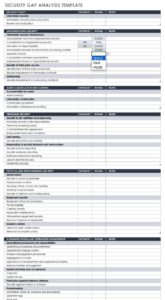Business analysts play a pivotal role in bridging the gap between business stakeholders and technical teams. They are responsible for gathering, documenting, and analyzing requirements to ensure that software solutions align with business objectives. A well-defined requirement gathering template is an indispensable tool for business analysts, allowing them to capture and organize critical information in a structured and efficient manner. Let us delve into the details of an effective requirement gathering template for business analysts.
Elements of a Comprehensive Requirement Gathering Template
A comprehensive requirement gathering template should include the following elements:
- Scope and Objectives: Clearly define the scope of the project and its primary objectives. This provides context for the requirements gathering process.
- Stakeholder Analysis: Identify all stakeholders involved in the project, including their roles, responsibilities, and influence. This understanding helps ensure that all relevant perspectives are considered.
- Functional Requirements: Capture the specific functions and features that the software solution must provide. These requirements should be detailed and measurable.
- Non-Functional Requirements: Define the qualities and attributes of the software system, such as performance, security, usability, and maintainability. These requirements ensure that the system meets the overall business needs.
- Business Rules: Document the business rules that govern the operation of the software solution. These rules define the constraints and limitations that must be adhered to.
- Acceptance Criteria: Establish the criteria that must be met for the software solution to be considered acceptable by the stakeholders. This ensures that there is a clear understanding of the expected outcomes.
Benefits of Using a Requirement Gathering Template
A requirement gathering template offers numerous benefits for business analysts:
- Ensures Consistency: A standardized template helps maintain consistency in the way requirements are captured and documented, reducing errors and misunderstandings.
- Streamlines the Process: A well-designed template streamlines the requirement gathering process, making it more efficient and effective.
- Improves Communication: A clear and well-organized template facilitates communication between business analysts, stakeholders, and technical teams.
- Reduces Risk: By capturing and documenting requirements in a structured manner, the template helps reduce project risk by preventing omissions or misinterpretations.
- Enhances Collaboration: A template promotes collaboration by providing a shared platform for stakeholders to contribute their inputs and feedback.
Conclusion
A requirement gathering template is an essential tool for business analysts, enabling them to efficiently and effectively gather, document, and analyze requirements. A comprehensive template ensures that all relevant information is captured, reducing errors and misinterpretations. The benefits of using a standardized template include improved communication, streamlined processes, reduced risk, and enhanced collaboration, ultimately contributing to the success of software development projects. By utilizing a well-structured requirement gathering template, business analysts can bridge the gap between business objectives and technical implementation, delivering software solutions that meet the needs of the organization.

